Brihadeeswarar Temple in Thanjavur
The 11th-century Tanjore Temple, also known as the Brihadeeswarar Temple, or Rajarajesvaram after King Rajaraja, or Thanjai Periya Kovil in Tamil, is a Shaivite Hindu temple on the south bank of River Cauvery in Chola architectural style. Also referred to as Dakshina Meru (or the Meru of South), and the Great Living Chola Temple, Brihadeeswarar Temple is a UNESCO world heritage site.
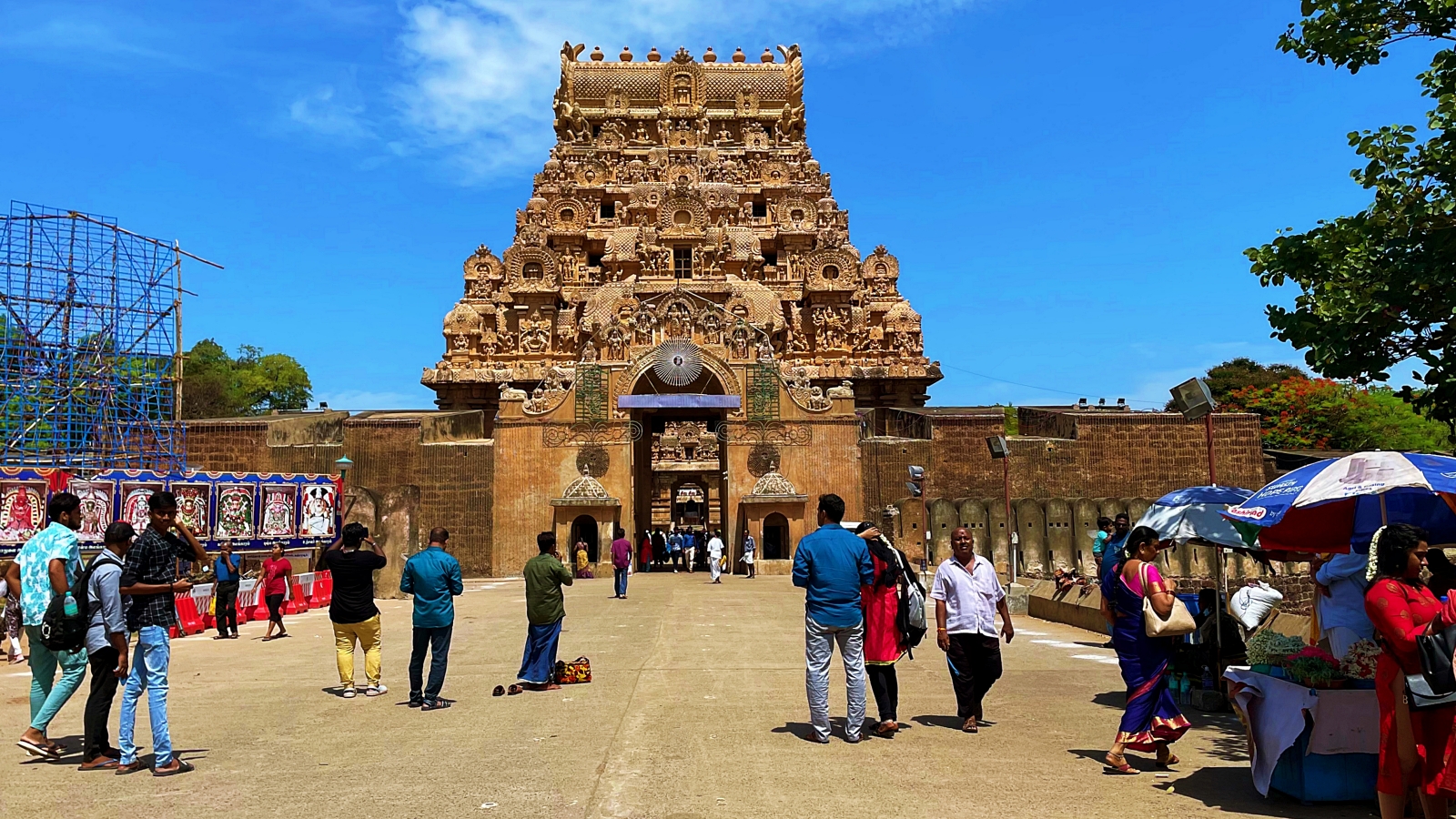
Situated in Thanjavur, Tamil Nadu, this awe-inspiring masterpiece showcases the pinnacle of Chola architecture and culture. Brihadeeswarar Temple nestled at the mouth of the Kaveri delta, is in close proximity to both the Bay of Bengal and the Indian Ocean, embracing the convergence of land and sea. This travel guide is a compendium of Brihadeshwara temple where we will unveil the secrets and mysteries that enshroud this architectural marvel, and delve into the depths of its enigmatic allure.
Table of Contents
Origins of Thanjavur and Brihadeeswarar Temple
Thanjavur, a city steeped in history and mythology, derives its name from the phrase ‘Than-sei-oor’, which translates to a land embraced by meandering rivers and lush paddy fields. Legend has it that this mystical name also owes its origins to a certain Tanjan, a fearsome Demon who met his untimely demise right here. This asura requested the creation of a splendid city in this very spot, as per Hindu mythology. However, the tables turned when the mighty Hindu god Neelamegha Perumal, a formidable incarnation of Vishnu, valiantly vanquished the asura, forever etching his name in the annals of Thanjavur’s history. And so, Thanjavur rose from the ashes of this epic battle, becoming a testament to the triumph of good over evil.
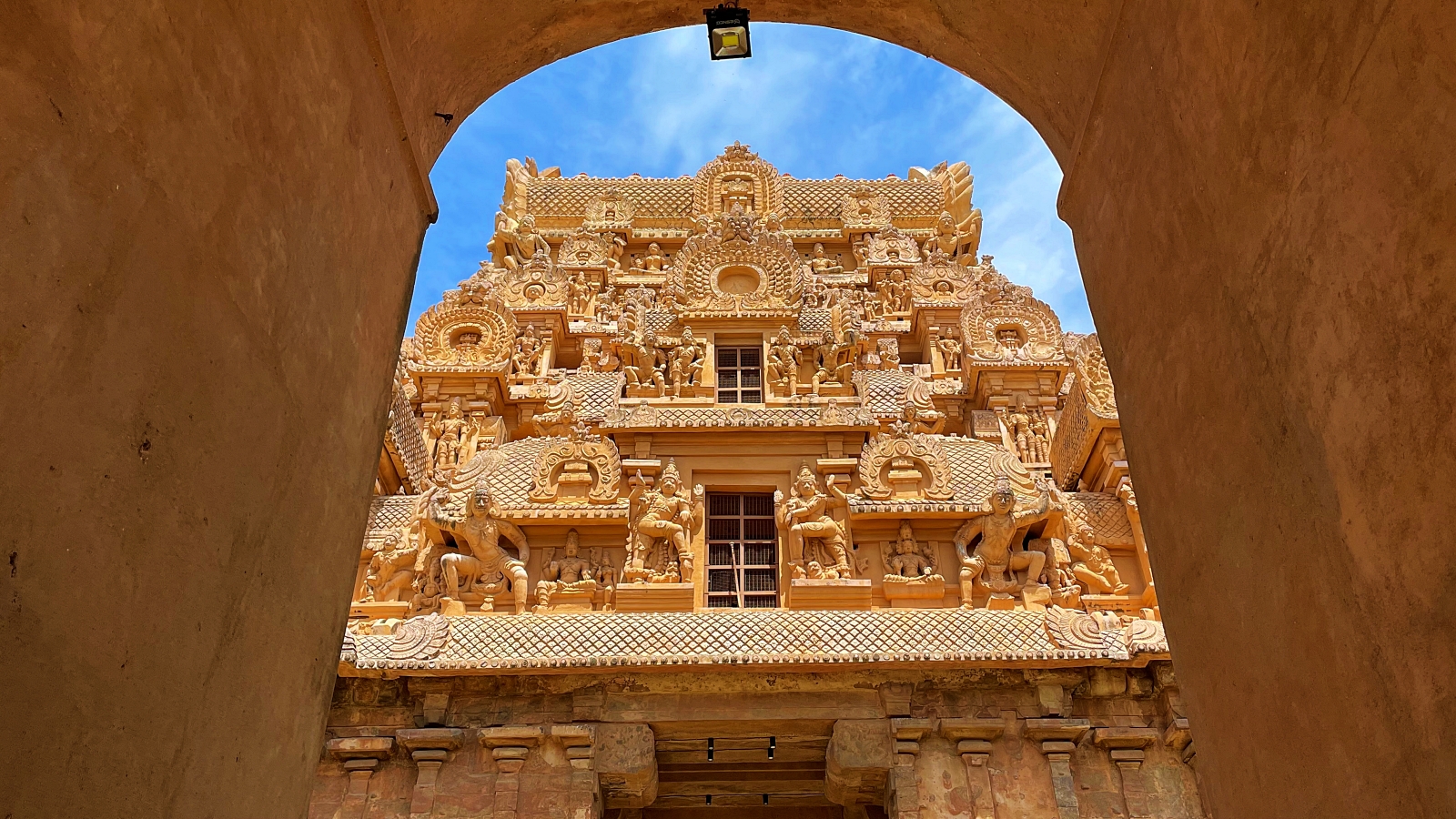
The city stands tall, a living testament to the power of myth and the resilience of its people. The Big Thanjavur Temple has stood tall as a captivating marvel in Tamil Nadu for countless centuries. Oh, how its name resonates through the ages, signifying its status as a major place of interest! Today, the Brihadeeswarar Temple continues to allure tourists from far and wide, yet it retains an ethereal aura of its glorious past. Now, let’s delve into the fascinating tale of its name.
Is it Thanjavur or Tanjore? Ah, the eternal question! Thanjavur, my dear chums, is the original name of the town where the magnificent Brihadeeswarar Temple proudly stands. However, the British invaders, bless their hearts, couldn’t quite grasp the intricacies of spelling and pronunciation. Thus, they bestowed upon it the version of Tanjore. But we shall not succumb to such linguistic missteps. Instead, we shall embrace the true essence of this grand temple and refer to it by its rightful name, Sri Brihadeeswarar Temple.
The very name, Brihadisvara Temple, derives from the Sanskrit language. It is a fusion of two words, namely Brihat and Ishvara. Now, my astute friend, let me unravel the hidden meanings behind these linguistic gems. Brihat signifies grandeur, greatness, and sheer magnificence. It is a word that resonates with power and awe-inspiring beauty. On the other hand, Ishvara refers to none other than the mighty Lord Shiva himself – the supreme soul, the very essence of divinity.
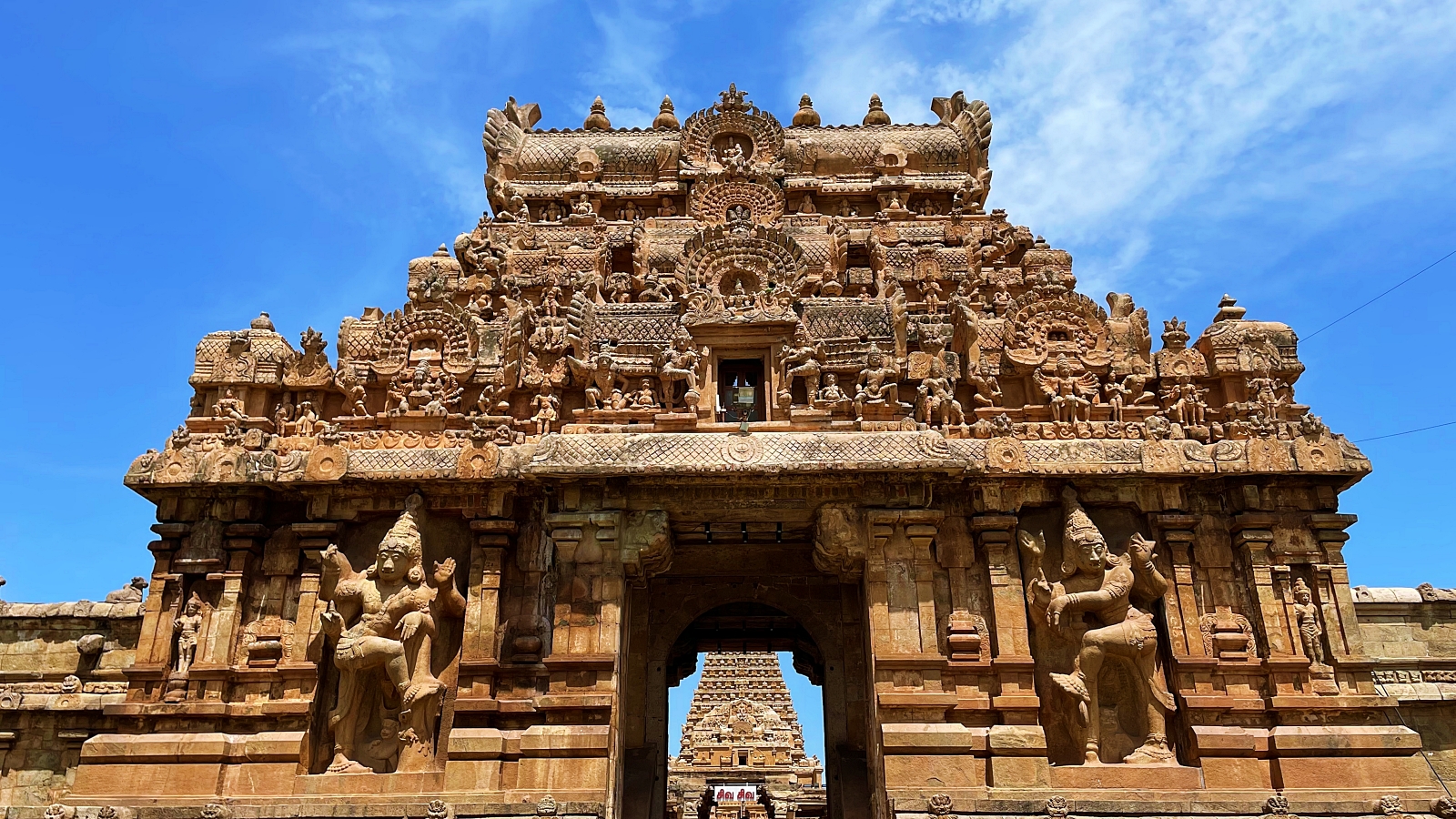
The Brihadeeswarar Temple boasts a history that stretches back thousands of years. The Cholas, a mighty dynasty, burst onto the scene during the 8th century C.E. They were like a force of nature, conquering the Pallavas left and right, and skyrocketing to unimaginable power. Fathom five centuries of absolute dominance! And, they used all that time to cultivate the most exquisite art and architecture you could ever lay your eyes on. It was like a masterclass in creativity, a symphony of beauty that still leaves us in awe to this day.
During this remarkable era, the visionary Chola founder, King Vijayalaya, bestowed upon Thanjavur the prestigious title of being the very first capital of the illustrious Chola Empire. And lo and behold, the Tanjore temple emerged as the ultimate embodiment of the Chola’s artistic and architectural brilliance! As time marched on, this magnificent temple fell under the rule of the mighty Marathas and the esteemed Nayakas, who, in their wisdom, decided to leave their own indelible mark on the Tanjore temple complex, thereby elevating its overall grandeur to unprecedented heights. Cholas finally met their match in the Pandyas during the 13th century. It was a bitter defeat, but hey, at least they had an incredible run, right?
Mastermind Behind the Brihadeshwara Temple
The mastermind behind the Tanjore Temple was none other than the legendary Tamil king, Raja Raja Chola I, and his sister Kundavai. These two were devout followers of the lord Shiva, displaying a level of dedication that would make your jaw drop. Raja Raja held dominion over the Thanjavur from 985 C.E. to 1014 C.E. Born as Arulmoli Varman, Raja Raja possessed a prowess that set him apart from the mere mortals of his time. With a flick of his royal wrist, he commanded the construction of the Tanjore Temple, a masterpiece that would leave even the most seasoned architects green with envy.
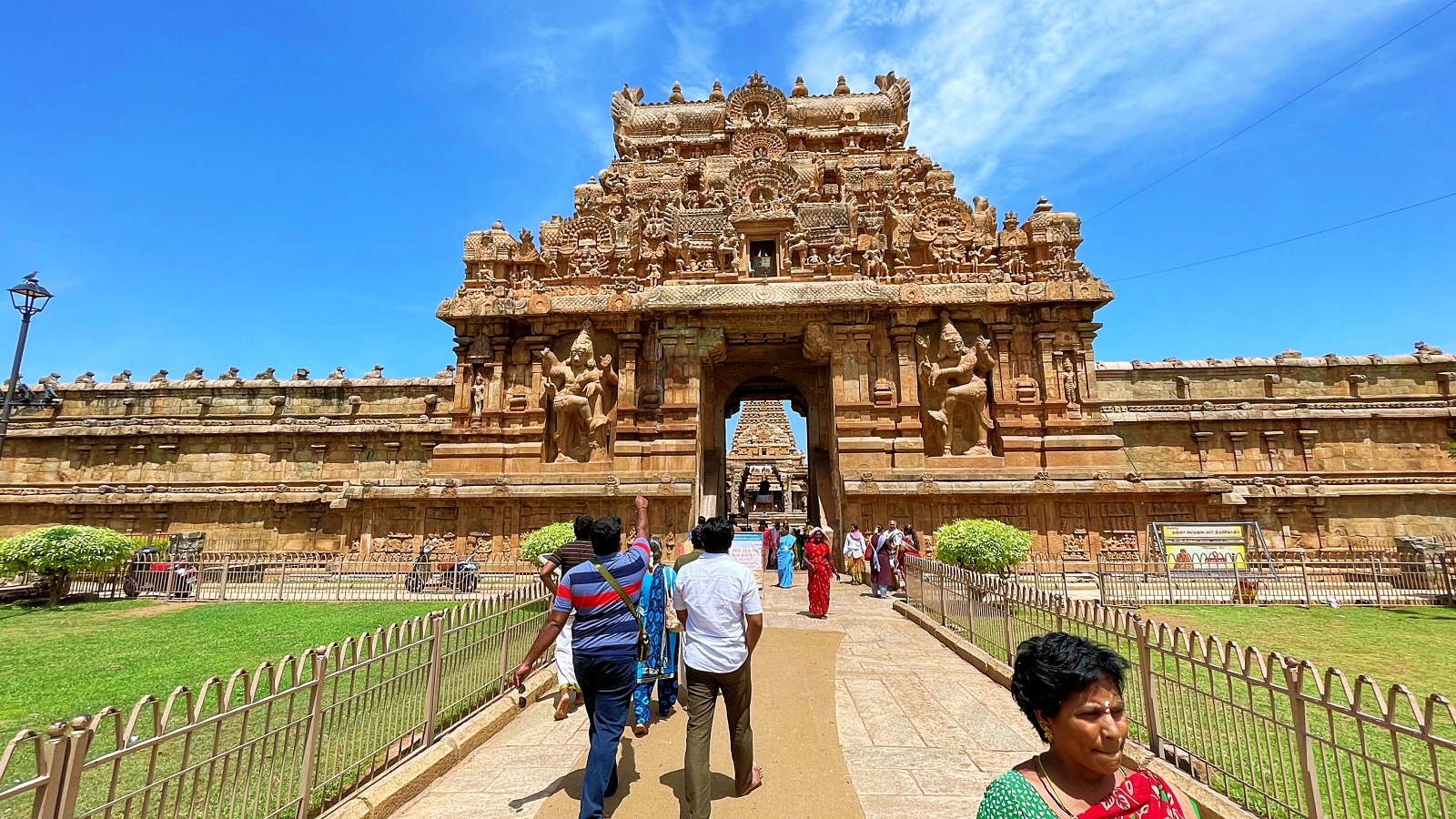
Even today, this architectural marvel stands tall as a testament to his visionary genius. But the unsung hero of this tale is Kundavai, his sister who offered her unwavering support and wisdom. Together, they were spiritual warriors, fighting for the glory of their beloved deity. Kunjara Mallan Raja Raja Perunthachan, the esteemed Chief Architect of the magnificent Brihadeshwara Temple in Tanjore, deserves all the credit for this architectural marvel. His descendants are still kicking around, mastering the art of Vastu Shastra, the Hindu architecture science. The temple’s spellbinding design is so intricate that it would take days to fully appreciate its grandeur.
Even the tiniest details of the Tanjore Temple can easily slip past our oblivious gazes if we’re not on high alert. It’s like a hidden treasure trove, waiting to be discovered by those with a keen eye for beauty and craftsmanship. With the creation of this masterpiece, Kunjara Mallan Raja Raja Perunthachan etched his name into the glorious annals of Chola history, forever leaving his mark on the world.
The Reign of Raja Raja Chola I
Raja Raja Chola I ruled over western and southern Tamil Nadu, Kerala, Kalinga (Odisha), Lakshadweep, Ezham (northern Sri Lanka), and the Maldive Islands. The Chola Kingdom’s influence stretched far beyond, reaching South East Asian nations like Indonesia and Malaysia. The empire of Raja Raja Chola reached as far as present-day Sri Lanka, that tiny island nation nestled at the southern edge of India. Raja Raja Chola I’s dominion knew no bounds. He and his son Rajendra I wielded unrivalled power in Sri Lanka from 993 C.E. to 1070 C.E.
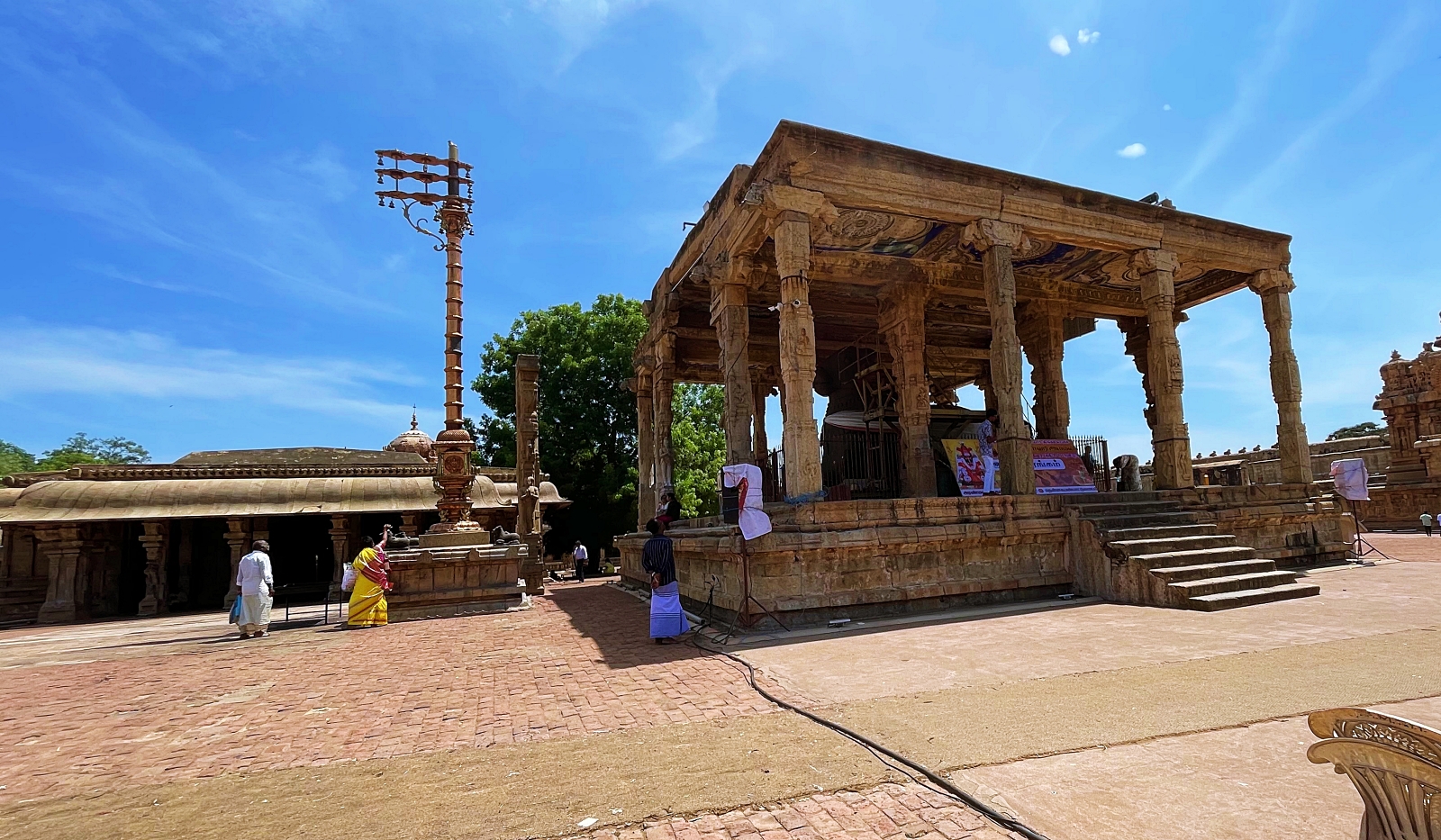
Legend has it that the Brihadeshwara Temple in Tanjore was born from a dream that struck him in Sri Lanka. An ancient 1000-year-old Shiva Temple in Mantota, now known as Rajaraja-pura, stands as one of the few surviving Hindu temples in Sri Lanka. Another ancient Shiva Temple is in the heritage town of Polonnaruwa (Jananatha Mangalam) in Sri Lanka.
History of the Brihadeeshvara Temple
This Hindu temple is a true ancient marvel, standing tall for over a thousand years. It proudly holds the title of being one of the oldest surviving Shiva temples on the face of this planet. Let me take you back in time, to the era of the great Chola emperor, Raja Raja Chola I. It was during his reign, between the years 1003 and 1010 C.E., that the Brihadeeshvara Temple was commissioned. Fast forward to the year 2010 C.E., and this architectural masterpiece celebrated its glorious millennium. However, this isn’t just some ancient relic gathering dust. It is still a thriving place of worship, where devoted followers come to pay their respects.
Brihadeeswarar Temple Architecture
Serving as a testament to Tamil architecture, the Brihadeshwara Temple Complex is built with a staggering 130,000 tonnes of granite. During my visit to this temple, I was utterly astounded by its attention to detail. The architecture of the Brihadeshwara Temple is simply beyond belief, such as its towering Vimanas, built with interlocking bricks, with not a speck of cement in sight. Similar to the pyramids of Egypt, no binding material was ever employed to keep those bricks in their rightful place. In the face of formidable earthquakes, the structure not only endured but stood the test of time. Ancient Hindus were light years ahead of their Western counterparts even in the 11th century C.E.
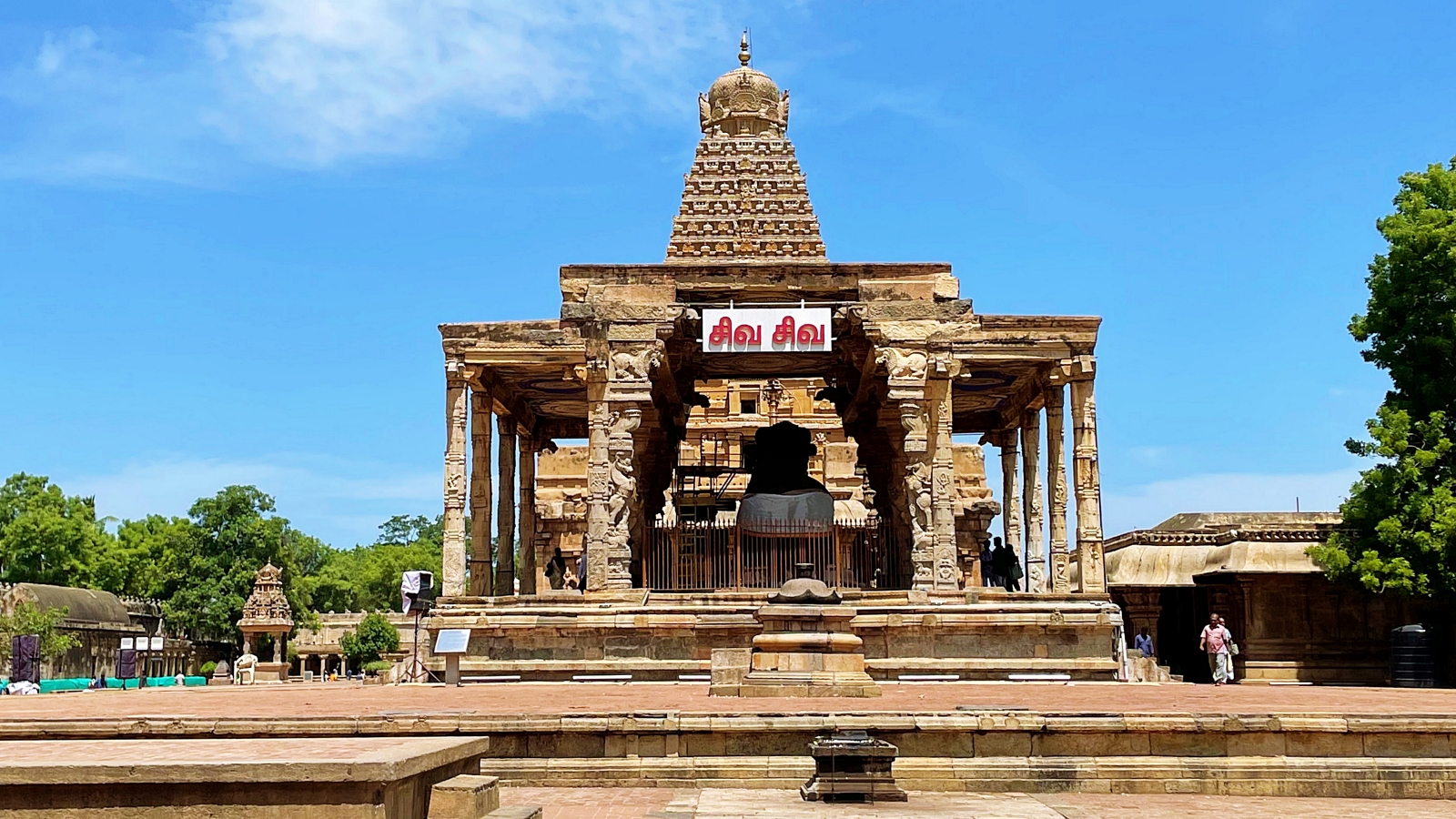
From its towering Shikhara to the majestic Shiv linga and the colossal Nandi Bull, the Brihadeshwara Temple is an absolute behemoth. The main Vimana of Sri Brihadeeswarar temple stands tall at a whopping 216 feet. The complex of Brihadeshwara Temple is built in a square shape, adding an extra dose of geometric awesomeness to this already mind-blowing structure. It stretches 790 feet from East to West and 400 feet from North to South. The Rajarajan Tiruvasal boasts the colossal figures of two Dwarpalikas, also known as the guards or gatekeepers. These gatekeepers stand tall, flanking the arched entrance, eagerly beckoning one to embark on a journey through the grand temple.
I was absolutely awestruck as I caught my first glimpse of the Vimanas, the central temple, and the Nandeshwara Bull from Rajarajan Tiruvasal. Look at the well-designed pavilions called Ardhapandapam, which connect the sanctum with the main hall within the temple complex. A giant statue of the Nandi Bull is housed in the Nandi Mandapam, a sizable hall that is situated opposite the Mukh Mandapam’s entrance. The Nandi Bull is Lord Shiva’s friend, savari, and guardian. There will always be a Nandi Bull facing the Garbhagriha in a Shiva Temple. In front of the Nandi Mandapam is a conventional oil lamp.
There are 8 Nandi idols in total, each facing one of the four cardinal directions. Each Nandi bull that is positioned atop the temple is 6 feet 6 inches by 5 feet 6 inches in size. The Nandi bull has a length of 19.5 feet and a width of 8.2 feet. The majority of worshippers walk around the Nandi as it is located on a high platform beneath the Nandi Mandapam. Whether the great Marathas or the Nayakas ordered these murals, historians argue. The Sri Vimana building is another remarkable one. The community hall, Mukhamandapam, is another great building. It is a sizable assembly space.
The Stupa perched on the granite rock is 12.5 feet tall. The entire stupa was coated in gold, however, over a period of time, it has been completely stripped of all its gold. Shiva devotees walk around the main temple grounds in the prakhara, a 1,480-foot-long pillared veranda. Within the complex of temples are other Hindu shrines dedicated to Parvati, Ganesh, Kartikeya, Dakshinamurti, Varahi, Sabhapati, and Chandeshvara.
Ashtadikpala Idols and 3 Gopurams
The Brihadeeswarar Temple is an absolute trove of captivating elements. Prepare to be enthralled by the presence of the Ashtadikpala idols, the mighty guardians of the eight directions as dictated by the esteemed Sanatan Dharm. Now, here’s a little twist that sets this temple apart from its South Indian counterparts. It’s Gopuram, is smaller than the Sri Vimana. Why, was this exception made? It’s a conundrum that continues to baffle even the most astute scholars. But wait, there’s more! During the reign of the Marathas, the Tanjore temple served a dual purpose.
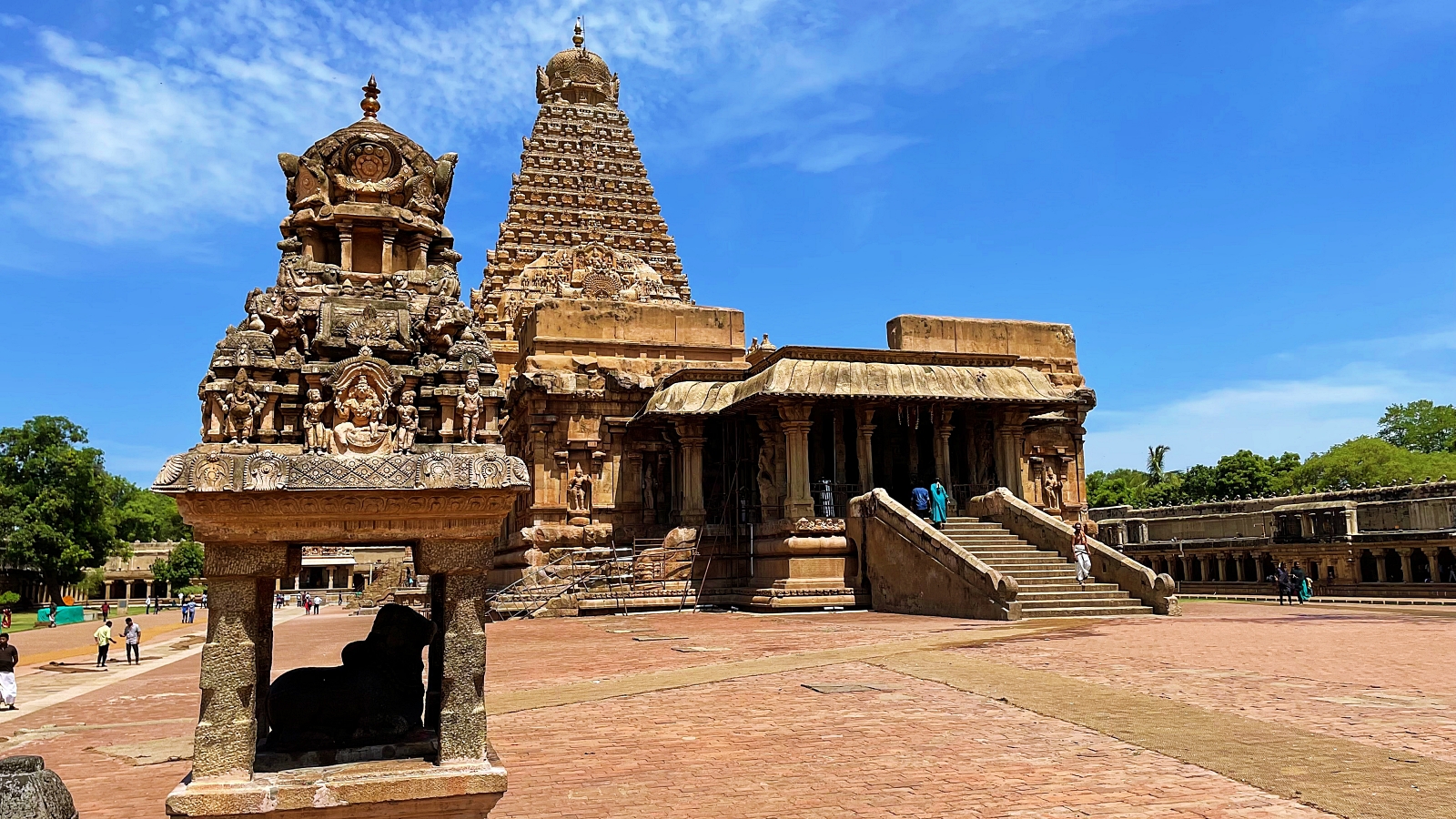
Not only was it a place of worship, but it also moonlighted as a watchtower, just like the Shore temple in Mamallapuram, Tamil Nadu. To fortify their stronghold, the Marathas and Nayaks went all out. They added an array of fortifications, including new temples, walls, gates, gopurams, and even moats! It’s as if they were saying, “We shall protect this temple with all our might!” Within the boundaries of the revered Brihadeeswarar temple, there are three Gopurams altogether. You can only enter the main courtyard after passing through all three gopurams.
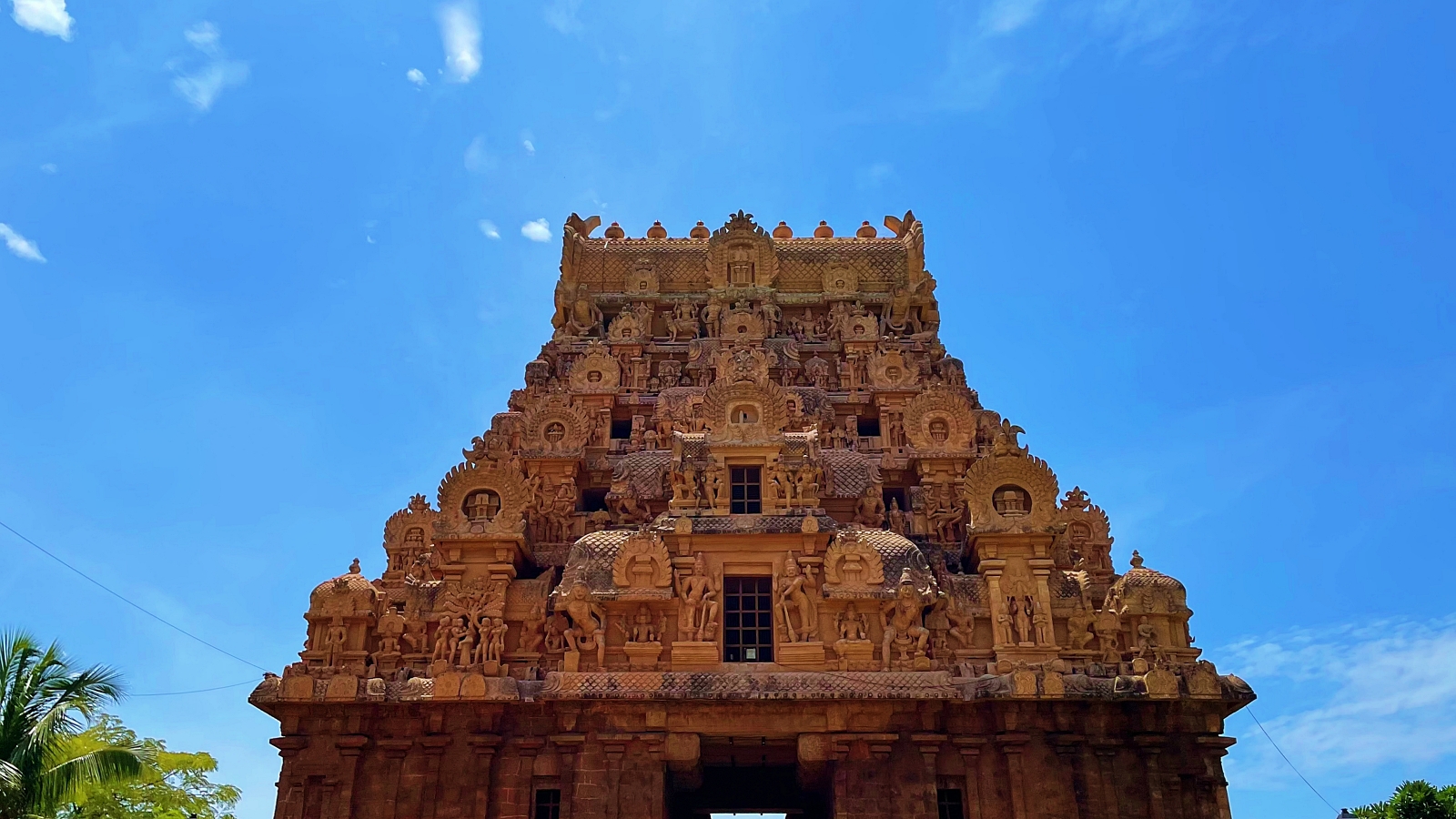
Marathas built the Brihadeeswarar Temple’s first Gopuram. The Maratha Gopuram or Maratha Gate are other names for it. The Brihadeeswarar temple needed protection, hence this fort gate was constructed. Since it was constructed as a protective wall, you may still see remnants of the moat here. The Keralantakan Tiruvasal is the second Gopuram. It is a gopuram, or intricately ornamented gate, with fine stone sculptures. According to historians, the Keralantakan Tiruvasal was built to honour the great King Raja Raja Chola’s victory over the Cheras. It was given that name in honour of Raja Raja Chola. Rajarajan Tiruvasal is the Brihadeeswarar temple’s third Gopuram.
Among the myriad carvings adorning the 3rd Gopuram, some of the most significant ones depict the divine union of Shiv ji and Maa Parvati, as well as the valiant Arjun ji from the legendary Hindu epic Mahabharat, triumphantly wielding the renowned Pashupati Astra bestowed upon him by Shiv Bhagwan himself. As you explore further, you will find carvings featuring a reclining Vishnu, sages, warriors, dancers, archers, and the sacred Nandi bulls. The Rajarajan Tiruvasal, the third and final Gopuram of the Tanjore Temple, boasts an exquisite collection of carvings primarily centred around the life of Shiv himself. As you delve into this architectural marvel, you will notice that every carving tells a story.
Breehadeshwara Temple Shiv Linga
Prepare to be humbled by the sheer size and beauty of the Shivlinga, standing tall like a beacon of divinity. The Shivlinga of Brihadeshwara Temple stands tall and proud, boasting its status as one of the tallest Shivlingas in the entire world. This monolithic lingam within the Brihadeeswarar temple reaches a staggering height of 29 feet. It’s so massive that it occupies not just one, but two entire storeys of the Garbhagriha, the sacred sanctum sanctorum. The height of the Vimana (tower) reaches an astonishing 208 feet. The Brihadeshwara Temple, with its impressive Gopuram, mighty plinth, and vast fresco-filled expanse, is a sight to behold. It boasts a stunning 5-storey Gopuram, standing tall at the main entrance. We’re talking about a height of 98 feet here, which, let’s be honest, is a tad shorter than the Vimana.
Garbhagriha Shiva Linga
Few are aware that this Shivlingaa stands tall as one of the loftiest in the entire world. It is an absolute must to venture into the garbhagriha and witness the divine presence of the Shivalingaa. Engaging in prayer and offering your heartfelt devotion to this sacred symbol is an experience that should not be missed. However, it is important to note that photography and videography are strictly prohibited within the Garbhagriha.
Mandapa Shiv Linga
A grand total of 108 Shivlingas grace the hallowed halls of this Mandapa. In the realm of Sanatan Dharm, also known as Hinduism, the number 108 holds immense significance, symbolizing auspiciousness and divine blessings. These ancient Shivlingas were crafted under the patronage of the esteemed Maratha ruler, Saraboji. The upapitham measures 140 centimetres, while the adhishthanam takes the cake with a colossal 360 centimetres. This temple is an enigma that has left historians scratching their heads.
A towering 16-storey temple, with 13 of those floors gracefully tapering into squares. And the square where the Vimana sits measures a whopping 99 feet. The dome, also known as the Kumbam or capstone, perched atop the Vimana, is not your ordinary dome. It’s octagonal, weighing 25,000 kilograms. The granite block that supports this colossal dome weighs a mind-numbing 80,000 kilograms. It’s like a mountain of stone, defying gravity and challenging the limits of human engineering.
What makes Brihadeeswarar Temple Extraordinary?
Brihadeeswarar Temple is a magnificent structure, renowned for its unparalleled grandeur and rich historical significance. First and foremost, let’s talk about its sheer size. Prepare to be awestruck as you gaze upon the towering vimana (temple tower), which reaches for the heavens like a determined acrobat. Standing at an impressive height of over 200 feet, it proudly proclaims its dominance over the surrounding landscape. But size isn’t everything, my dear reader. The Tanjore temple boasts an architectural finesse that will leave you spellbound. Intricate carvings adorn every inch of its walls, depicting tales from ancient mythology and showcasing the artistic prowess of the craftsmen who brought this masterpiece to life.
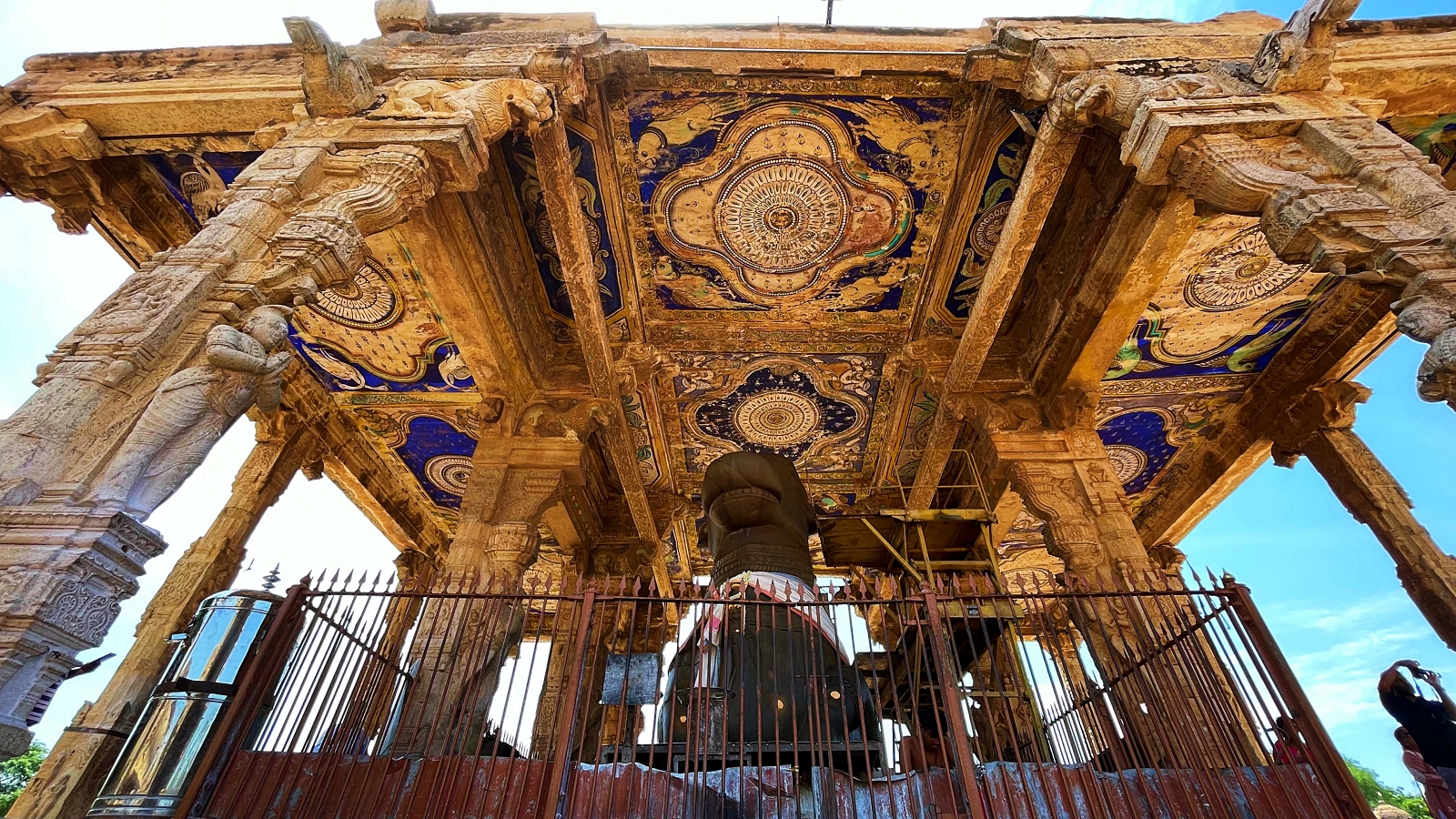
Each sculpture seems to come alive, whispering stories of gods and goddesses, battles and triumphs, as if they were performing a captivating dance just for you. Beyond its physical splendour, the Tanjore temple holds exquisite Thanjavur dolls, the Chola Bronze collection, and mind-blowing 3D paintings adorned with shimmering gold leaf. The area surrounding Tanjore is a treasure trove of artistic brilliance and architectural wonders, like a cultural explosion that will blow your mind. You simply cannot claim to have experienced Tamil Nadu tourism without paying a visit to the Brihadeeswarar Temple.
Mysteries Enshrouding Brihadeeswarar Temple
The Brihadeeswarar Temple of Thanjavur is shrouded in an air of intrigue, boasting a plethora of mysteries and secrets waiting to be unravelled. Among the renowned enigmas surrounding this magnificent temple is the enigmatic shadow it casts, the clandestine underground passages that lie beneath its sacred grounds, the mind-boggling construction techniques employed in its creation, the enigma of the granite used, and even the presence of a European man adorning its ancient walls.
The Brihadeeswarar Temple boasts a staggering count of 100 clandestine subterranean passages nestled within the depths of the Tanjore Temple’s basement. These covert conduits, intricately linked to the King’s palace and various neighbouring locales, once served as the clandestine thoroughfares for the esteemed members of the royal family, enabling them to gracefully traverse their desired destinations.
Numerous additional temples are included within the vast Sri Brihadeshwara temple complex. You may see all the separate temples near the Brihadeshwara temple by performing a parikrama around the compound. For instance, the Ammam Mandir, a shrine dedicated to the goddess Parvati, is known as the mother’s temple. The Amman shrine has some of the best stone carvings, statues, paintings, and murals. In the 13th century A.D., a Pandya king built the Amman Temple. After the Tanjore temple was finished, it was the first later addition to the complex of temples.
In the 17th century C.E., the Marathas added the Mandapam. Here, you may see the finest examples of Pandyan architecture. Nandi Mandapam’s neighbour is the Nataraja Mandapa. Serfoji II of the Maratha Empire ordered the construction of the Nataraja temple in 1800 A.D. Late in the 18th century C.E., the great Maratha emperor Sarabhoji ordered the construction of a Ganesh temple. The Sri Vimana is directly behind this temple. A complex temple with numerous large carvings is the Subramanya Temple, which is dedicated to Kartikeya, the son of Lord Shia and Parvati.
In the 16th and 17th centuries C.E., the Nayaka kings constructed Subrahmanya Mandir. One of the most remarkable examples of Nayaka architecture is the Subrahmanya shrine. A gopuram and a flat roof part are included in the Subrahmanya mandir’s two components. The Chandikesvara Temple is near the Subrahmanya Temple. Apart from the Brihadeshwara Temple, the only other shrine that was first constructed by the Cholas is the Chandikeswara Temple.
The Karuvur Dewar Temple is not as opulent as the complex’s other temples. Karuvur Dewar, the guru, leader, and instructor of the great King Raja Raja Chola, is the subject of this temple. Hindu devotees bind clothing and threads to a tree at this tiny shrine. Maha Varahi Amman’s shrine is located inside Thanjavur’s Brihadeeswarar Temple, also known as Thanjai Periya Kovil. Hindu worshippers pray to Sri Varahi Devi to grant their requests, remove Drishti dosha, and obtain protection from unfavourable events.
The Other Breehadiswara Temple
Gangaikonda Cholapuram Temple, also known as another Breehadiswara Temple, is located a mere 70 km southwest of its sibling in Thanjavur. This temple, dedicated to the mighty Shiva, may be smaller in size, but it’s a refined gem that will leave you in awe. Constructed in the year 1035 AD by the illustrious Rajendra Chola I, son of the legendary Raja Raja Chola, this temple is a testament to the architectural prowess of the Chola dynasty. One of the highlights of this temple is a captivating sculpture depicting Lord Shiva himself, garlanding the King. It’s a sight that will make you marvel at the divine connection between the earthly and the celestial. Pay a visit to the Gangaikonda Cholapuram Temple and let its grandeur and history wash over you.



